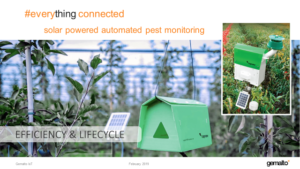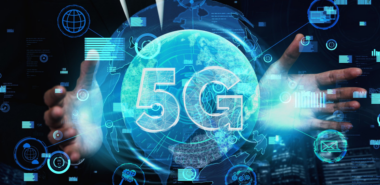
In October 2018, scientists published a report that stated we have 12 years to stop the planet warming above 1.5C. To achieve this, by 2050 greenhouse gas emissions must be reduced by 40 to 70 percent below the levels they were at in 2010, according to the United Nations (UN) Intergovernmental Panel on Climate Change.
To try limit the warming of the earth’s atmosphere, states from around the world signed up to the Paris Agreement in 2016. As of May 2019, 184 countries and the European Union have ratified the treaty and each of these countries now has at least one national climate law or policy in place.
Nonetheless, with new reports from the UN suggesting the world is set to miss the Paris climate targets by wide margin, a transformation towards a low carbon future is needed… and fast.
So, what can we do? There are many ways we as individuals can reduce our impact on climate change, but one area that warrants further attention is the Internet of Things (IoT). According to a new report by Ericsson, the IoT could help reduce greenhouse gas emissions by up to 63.5 gigatons, or 15 percent, across all industrial sectors by 2030. By providing industry sectors with greater efficiencies, the emerging connected world can become a cleaner, more sustainable place. With this in mind, we have listed below three examples of exactly how IoT products could benefit the planet.
Preventing Deforestation
Deforestation accounts for 15 percent of all global carbon emissions, so reducing its impact will be crucial for preventing a rise in greenhouse gas emissions. To decrease the rate of deforestation, San Francisco start-up The Rainforest Connection makes sensors from old mobile phones that they attach to trees, allowing their teams to monitor and detect illegal logging and animal poaching. The sensors collect a huge amount of data, listening for certain sounds associated with illegal logging. When the sounds are detected, the company sends the information to the local authorities, so they can stop illegal activity in real-time.
What is more trees have been able to talk or ‘cry for help’ since we contributed to a project dedicated to protect the Amazon rainforest six years ago (we blogged about it here).
Before this technology, local authorities had to come across illegal logging by accident, however now they can use a lot more effective targeted approach. Using and sharing the data from the IoT in this way also helps to negotiate with the government to demonstrate the extent of logging and secure increased protections of rainforests in some of the most vulnerable areas.
Precision Agriculture
According to the UN Food and Agriculture Organization, in order to feed our growing population, farmers across the globe will have to grow 70 percent more food in 2050 than they did in 2006. To avoid cutting down trees to make space for farming land, which contributes significantly to climate change, farmers can use the IoT to make their current fields more efficient and waste-less.
IoT Agriculture company DTN, for example, has developed a wireless ‘smart trap’ to enable farmers to protect their crops. The smart traps are fitted with pheromones to attract the pest and monitor the population in real-time. This data is then sent to a transmitter, which sends it directly to an app on the farmer’s phone. The farmer can then take immediate action and make the most informed decision about where to spray pesticides, increasing yields. By helping to automate the standard error-prone process and the guess work of determining where and how much pesticide to use in a field, the company hopes to mitigate the $20 billion dollars’ worth of damages in the United States due to the crop pests and the annual use of $4.1 billion dollars’ worth of chemicals applied in prevention methods.
Furthermore, our customer EFOS d.o.o. has developed a solar-powered automated pest monitoring solution called Trapview, which monitors all kinds of insects that can be lured into insect traps. Integrated 2G, 3G and LTE connectivity allows reliable automatic data collection.

Another good example of precision agriculture enabled by the IoT comes from UK business called the Small Robot Company that builds small robots that seed and care for each individual plant. They will only feed and spray the plants that need it, giving them the perfect levels nutrients and support, with no waste. The small robots recognize and laser-zap weeds to eliminate the need for pesticides.
Protecting Wildlife
As we all know, there are many delicate ecosystems on the planet that are threatened by habitat destruction, hunting, rising temperatures and the acidification of water which is destroying plants that many animals feed on. In fact, of the 87,967 species in the world in 2018, 25,062 were in danger of extinction and as many as 30 to 50 percent of the planet’s species may be extinct by 2050. However, the good news is that the IoT can help conservation efforts both on land and sea to help bring back species on the brink of extinction.
Despite being protected under the Endangered Species Act and the Marine Mammal Protection Act, The West Indian manatee or Dugong has been hunted for thousands of years for its meat and oil. With a worldwide decline of 20 percent in the last 90 years, Dugong’s have disappeared from the waters of Hong Kong, Mauritius, and Taiwan, as well as parts of Cambodia, Japan, the Philippines and Vietnam. In 2016, IoT provider Kii announced it was teaming up with the Smart Earth Network for a major conservation effort in the Philippines to help track the local population of dugongs.
Traditionally, in order to monitor the population of these animals, helicopters had to be used, which was expensive and not that reliable. However, using the IoT and a cloud platform, local fishermen, armed with smartphones, can now upload geo-located images of the sea mammals via an Android app. Each image indicates the location of each dugong via GPS, allowing conservationists to map the sightings and get a clear idea of the population in the area, timings of sightings and migration patterns. This data was then used to enable the team to put together recommendations for future protection areas.
The project was so successful that the technology from the app was integrated into an anti-poaching reporting app and deployed in a national park in Africa, although this effort needs to be sustained over the coming years to really make an impact.
We’ve contributed to a similar project to safeguard seal populations a couple of years back. Check out the nice shot of the Cinterion BGS2 module.
We hope this article was informative and enlightening in helping you understanding some ways how the IoT can be used to help reduce the environmental effects of human activities. However, we cannot solely rely on the IoT to save the planet, efforts by everyone are needed to protect our environment. And if you have any suggestions about other ways the IoT can be used to help the environment, feel free to tweet us @Gemalto.


